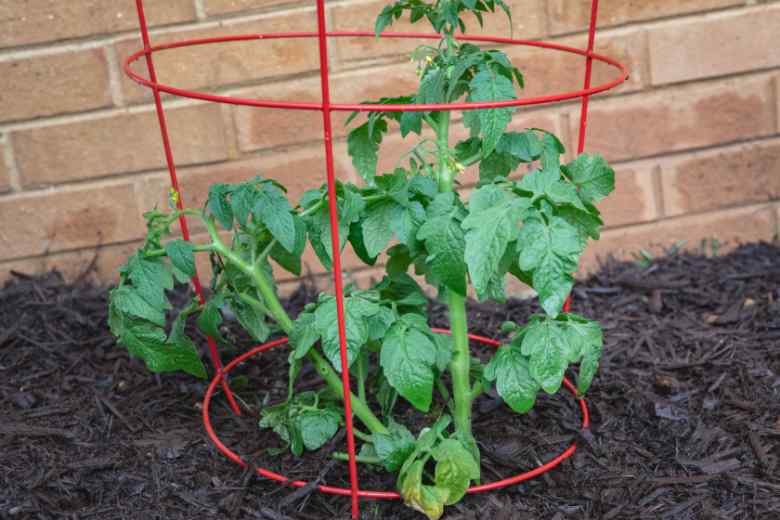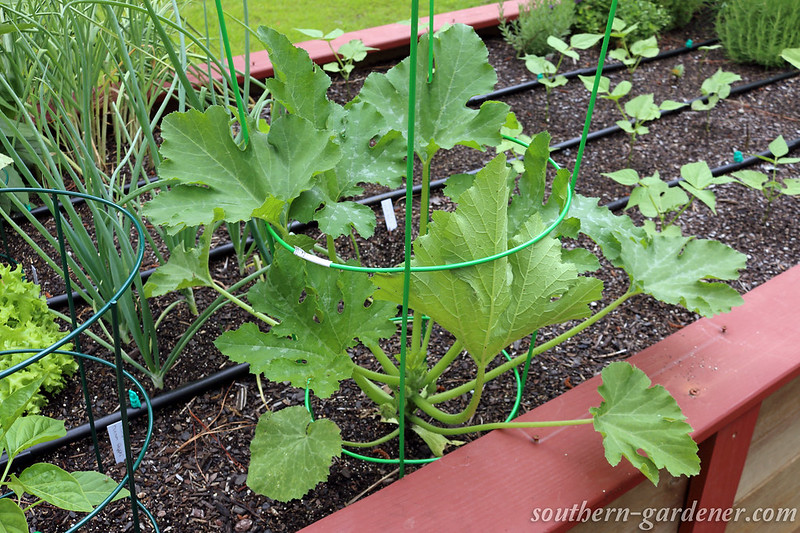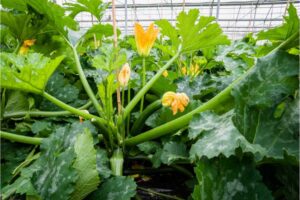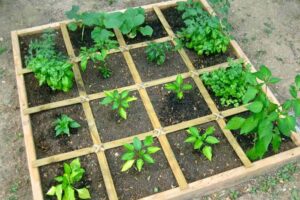
Tomato cages are a popular way to support and structure tomato plants as they grow in size and produce fruit. But can these same cages be used for other vegetables, such as zucchini?
The answer is yes! Tomato cages can be used for zucchini, but with a few modifications. The main issue is that zucchini plants have a much wider spread than tomato plants, so the cages must be widened with extra supports to provide adequate support for the zucchini plants.
With a few extra steps, tomato cages can be used to successfully grow zucchini.
What is a Tomato Cage?
A tomato cage is an essential tool for gardeners who want to grow tomatoes. It’s a metal or plastic frame that is used to support the tomato plants as they grow, providing stability and preventing them from falling over.
The cage also helps to keep the fruit off the ground, allowing it to ripen without being damaged. Tomato cages come in a variety of sizes and can be easily installed around the base of the tomato plants.
They are a great way to ensure healthy, productive tomato plants, and will help to keep your garden looking neat and tidy.
What are the Benefits of Using Tomato Cages?
Tomato cages are an essential tool for any serious home gardener. Not only do they provide the support needed for tall, heavy plants, but they also make it easier to manage and harvest your crop.
With the right tomato cage setup, you can more easily reach all parts of the plant and collect ripe tomatoes without damaging the vines.
Additionally, tomato cages can protect your plants from harsh weather, keep them from toppling over and make pest control and disease prevention easier.
Used correctly, tomato cages can even help increase yields by providing better aeration and improved drainage.
In short, using tomato cages is a great way to maximize your tomato-growing success!
What are the Limitations of Using Tomato Cages?
Tomato cages are an effective and efficient way to support the growth of tomato plants. However, they have their limitations.
Tomato cages cannot support the weight of large tomato plants growing with heavy fruit clusters, and they can be easily blown over by strong winds.
Furthermore, as tomato plants grow, they can become tangled in the cage itself, leading to damage or stunting of the plant growth.
Besides, tomato cages restrict the space of the tomato plant, which may limit its ability to produce larger fruit.
Finally, tomato cages are often aesthetically unappealing, and can be an eyesore in a garden or other landscaping area. For these reasons, it is important to consider the limitations of using tomato cages before investing in them.

How to Use Tomato Cages for Zucchini
Using tomato cages for growing zucchini is a creative gardening solution that can help to save space and keep your plants healthier. Zucchini plants are typically sprawling and require a good amount of space, but by using a tomato cage, you can guide the plant to grow upward, which can help avoid problems like powdery mildew and also makes harvesting easier.
Here’s a step-by-step guide to using tomato cages for your zucchini plants:
Step 1: Choose the Right Tomato Cage:
Tomato cages come in various sizes, but for zucchini, you’ll want a sturdy and large one. Zucchini plants can get quite heavy, so a robust cage is necessary. Also, consider the height of the cage – a taller one allows the zucchini plant more room to grow vertically.
Step 2: Prepare Your Garden Bed:
Zucchini prefers well-drained soil rich in organic matter. Prepare your garden bed by tilling it well and mixing in compost or well-rotted manure.
Step 3: Plant the Zucchini:
Place the zucchini seed or young plant in a hole about an inch deep, then gently cover it with soil. If you’re using seeds, you can plant two to three per hole and thin out the weakest seedlings once they sprout.
Step 4: Position the Tomato Cage:
Immediately after planting, place your tomato cage over the top. Try to center the cage over the plant, but be careful not to damage the young seedling. Push the cage into the ground as far as possible to ensure stability.
Step 5: Guide the Zucchini:
As the zucchini plant starts to grow, gently guide the stems through the cage, encouraging them to grow upwards. Use soft ties to help guide the stems if needed, but be careful not to restrict growth or damage the plant.
Step 6: Water and Fertilize:
Zucchini plants need a lot of water, especially as they start to produce fruit. Water deeply at the base of the plant to encourage deep root growth. Fertilize regularly using a vegetable-specific fertilizer to promote healthy growth and fruit production.
Step 7: Monitor and Harvest:
Check the plants daily for pests or disease. Harvest zucchini when the fruits are small to medium-sized for the best flavor and to encourage more fruit production. To harvest, cut the zucchini off with a sharp knife rather than pulling.
Remember, not all zucchini plants will take well to vertical growing, and some may require additional support beyond a tomato cage. But with some care and attention, you can successfully grow zucchini using tomato cages and enjoy a bountiful harvest.
Tips for Maximizing Zucchini Production with Tomato Cages
Here are some tips for maximizing your zucchini production when using tomato cages:
- Choose the Right Varieties: Some varieties of zucchini might adapt better to vertical growing than others. Research and select varieties known for their compatibility with vertical growth, such as ‘Black Forest’, ‘Raven’, or ‘Trombetta’.
- Provide Adequate Sunlight: Zucchini plants need a lot of sunlight to produce fruit. Make sure your garden bed gets at least 6 to 8 hours of direct sunlight per day.
- Mulch Around the Plants: Mulch can help retain moisture in the soil, discourage weeds, and reduce the chances of the fruit getting dirty or rotting. Straw or shredded leaves can make good mulch for zucchini.
- Proper Spacing: Even when growing vertically, zucchini plants need space to breathe. Giving each plant enough room helps with air circulation, reducing the risk of disease. Aim for spacing of around 36 inches between each plant.
- Regular Feeding: Zucchini plants are heavy feeders. Apply a slow-release, balanced fertilizer at planting time, and then supplement with a high-potassium fertilizer when the plants start to produce fruit.
- Prune When Necessary: Pruning can help increase air circulation, improve sunlight exposure, and reduce the risk of diseases. Remove the older leaves that are yellowing or are heavily infested with pests.
- Pollination: Sometimes, zucchini plants may have trouble with pollination, especially in areas with fewer bees. If you notice the flowers are dropping off without producing fruit, you may need to hand-pollinate. Use a small paintbrush or cotton swab to transfer pollen from male to female flowers.
- Regular Harvesting: Frequent harvesting encourages more production. Zucchini is best when harvested young and tender. The more you pick, the more the plant will produce.
- Monitor for Pests and Diseases: Regularly check your plants for common pests like squash bugs and cucumber beetles. If detected, use organic or chemical control methods as appropriate. Also, watch out for powdery mildew, a common zucchini disease, and treat with a fungicide if necessary.
- Rotate your crops: If possible, do not plant zucchini or other squash family plants in the same spot each year. Crop rotation helps to prevent diseases from building up in the soil.
By following these tips, you can maximize your zucchini production using tomato cages, leading to a successful and plentiful harvest.

Alternatives to Using Tomato Cages for Zucchini
Tomato cages are a popular choice for staking zucchini, but they aren’t the only option. There are several alternatives that you can use to provide support for your zucchini plants.
For example, stakes and trellises provide a more sturdy support than cages, while trellis netting and other forms of mesh can be used to create a framework to give your zucchini plenty of room to grow.
You can also use garden twine or stretchy strips of fabric to weave between the stems, helping to keep them upright. Whatever method you choose, make sure to provide your zucchini plants with plenty of room to reach their full potential.
FAQs About the Can You Use Tomato Cages For Zucchini
What size tomato cage should I use for zucchini plants?
Answer: Depending on the size of your zucchini plants, you may need a larger tomato cage. Generally, a 5-foot tomato cage is recommended for larger zucchini plants.
How many tomato cages do I need for my zucchini plants?
Answer: It depends on the size of your zucchini plants and how many you are growing. Generally, one tomato cage is enough for two or three plants.
Can I use a tomato cage for other types of plants?
Answer: Yes, tomato cages can be used for other types of plants, such as cucumbers, squash, and melons.
Conclusion
In conclusion, tomato cages can be used to grow zucchini. However, they may not provide the best support for the zucchini, since the tomato cages are designed for tomatoes and may not be the right size or shape for zucchini. It is recommended to use tall trellises or stakes instead for the best support.






